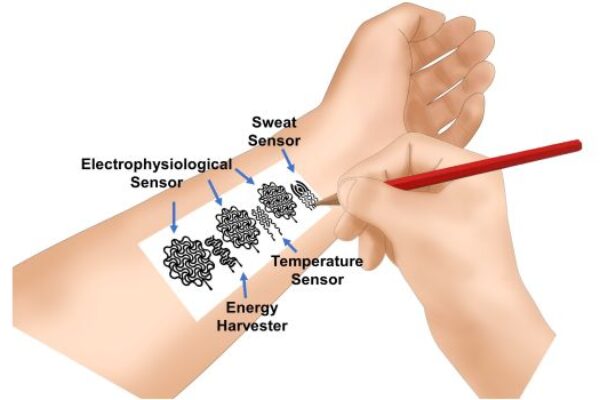
Pencil and paper technique creates on-skin electronics
By using widely accessible pencils and papers as tools, say the researchers, they have developed a variety of cost-effective and disposable on-skin electronic devices ranging from biophysical sensors and sweat biochemical sensors to thermal stimulators, humidity energy harvesters, and transdermal drug-delivery systems. This contrasts with current state-of-the-art on-skin electronics, which typically suffer from expensive precursor materials, costly fabrication facilities, complex fabrication processes, and limited disposability.
Many existing commercial on-skin biomedical devices, say the researchers, often contain two major components: a biomedical tracking component and a surrounding flexible material, such as plastic, to provide a supportive structure for the component to maintain an on-skin connection with a person’s body. In their work, the researchers found that pencil-drawn graphite patterns (or combined with other compounds) serve as conductive traces and sensing electrodes, and office-copy paper works as a flexible supporting substrate.
“The conventional approach for developing an on-skin biomedical electronic device is usually complex and often expensive to produce,” says Zheng Yan, an assistant professor in the College of Engineering. “In contrast, our approach is low cost and very simple. We can make a similar device using widely available pencils and paper.”
In their study, the researchers found that pencils containing more than 90% graphite were able to conduct a high amount of energy created from the friction between paper and pencil caused by drawing or writing. Specifically, say the researchers, they found pencils with 93% graphite were the best for creating a variety of on-skin bioelectronic devices drawn on commercial office copy paper. A biocompatible spray-on adhesive could be applied to the paper to help it stick better to a person’s skin.
The enabled devices, say the researchers, can perform real-time, continuous, and high-fidelity monitoring of a range of vital biophysical and biochemical signals from human bodies. These include skin temperatures, electrocardiograms, electromyograms, alpha, beta, and theta rhythms, instantaneous heart rates, respiratory rates, and sweat pH, uric acid, and glucose, as well as deliver programmed thermal stimulations.
The discovery, say the researchers, could have broad future applications in home-based, personalized health care, education, and remote scientific research such as during the COVID-19 pandemic. Next, the researchers say they are looking to further develop and test the use of the biomedical components, including electrophysiological, temperature, and biochemical sensors.
“For example,” says Yan, “if a person has a sleep issue, we could draw a biomedical device that could help monitor that person’s sleep levels. Or in the classroom, a teacher could engage students by incorporating the creation of a wearable device using pencils and paper into a lesson plan. Furthermore, this low-cost, easily customizable approach could allow scientists to conduct research at home, such as during a pandemic.”
An additional benefit to their approach, say the researchers, is that paper can decompose in about a week, compared to many commercial devices that contain components that are not easily broken down. For more, see “Pencil–paper on-skin electronics.”
Related articles:
Smart tattoos use biosensitive ink to monitor medical conditions
‘E-tattoos’ function as breathable sensors
Print-in-place electronics method works on skin, paper
 If you enjoyed this article, you will like the following ones: don't miss them by subscribing to :
eeNews on Google News
If you enjoyed this article, you will like the following ones: don't miss them by subscribing to :
eeNews on Google News




